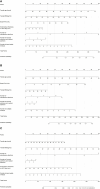Development and validation of a visualized prediction model for early miscarriage risk in patients undergoing IVF/ICSI procedures: a real-world multi-center study
- PMID: 38433972
- PMCID: PMC10905617
- DOI: 10.3389/fendo.2023.1280145
Development and validation of a visualized prediction model for early miscarriage risk in patients undergoing IVF/ICSI procedures: a real-world multi-center study
Abstract
Background: This study focuses on the risk of early miscarriage in patients undergoing in vitro fertilization (IVF) or intracytoplasmic sperm injection (ICSI). These patients commonly experience heightened stress levels and may discontinue treatment due to emotional burdens associated with repeated failures. Despite the identification of numerous potential factors contributing to early miscarriage, there exists a research gap in integrating these factors into predictive models specifically for IVF/ICSI patients. The objective of this study is to develop a user-friendly nomogram that incorporates relevant risk factors to predict early miscarriage in IVF/ICSI patients. Through internal and external validation, the nomogram facilitates early identification of high-risk patients, supporting clinicians in making informed decisions.
Methods: A retrospective analysis was conducted on 20,322 first cycles out of 31,307 for IVF/ICSI treatment at Sun Yat-sen Memorial Hospital between January 2011 and December 2020. After excluding ineligible cycles, 6,724 first fresh cycles were included and randomly divided into a training dataset (n = 4,516) and an internal validation dataset (n = 2,208). An external dataset (n = 1,179) from another hospital was used for validation. Logistic and LASSO regression models identified risk factors, and a multivariable logistic regression constructed the nomogram. Model performance was evaluated using AUC, calibration curves, and decision curve analysis (DCA).
Results: Significant risk factors for early miscarriage were identified, including female age, BMI, number of spontaneous abortions, number of induced abortions and medical abortions, basal FSH levels, endometrial thickness on hCG day, and number of good quality embryos. The predictive nomogram demonstrated good fit and discriminatory power, with AUC values of 0.660, 0.640, and 0.615 for the training, internal validation, and external validation datasets, respectively. Calibration curves showed good consistency with actual outcomes, and DCA confirmed the clinical usefulness. Subgroup analysis revealed variations; for the elder subgroup (age ≥35 years), female age, basal FSH levels, and number of available embryos were significant risk factors, while for the younger subgroup (age <35 years), female age, BMI, number of spontaneous abortions, and number of good quality embryos were significant.
Conclusions: Our study provides valuable insights into the impact factors of early miscarriage in both the general study population and specific age subgroups, offering practical recommendations for clinical practitioners. We have taken into account the significance of population differences and regional variations, ensuring the adaptability and relevance of our model across diverse populations. The user-friendly visualization of results and subgroup analysis further enhance the applicability and value of our research. These findings have significant implications for informed decision-making, allowing for individualized treatment strategies and the optimization of outcomes in IVF/ICSI patients.
Keywords: IVF-ET; early miscarriage; individualized prediction; nomogram; pregnancy outcome.
Copyright © 2024 Zhang, Ji, Hu, Zhu, Ma, Xu, La and Zhang.
Conflict of interest statement
The authors declare that the research was conducted in the absence of any commercial or financial relationships that could be construed as a potential conflict of interest. The reviewer XY declared a shared parent affiliation with the author(s) MZ, XJ, XH, YZ, and QZ to the handling editor at the time of review.
Figures





Similar articles
-
Low anti-Müllerian hormone level is not a risk factor for early pregnancy loss in IVF/ICSI treatment.Hum Reprod. 2020 Mar 27;35(3):504-515. doi: 10.1093/humrep/deaa008. Hum Reprod. 2020. PMID: 32219343
-
Development and validation of a model for individualized prediction of cervical insufficiency risks in patients undergoing IVF/ICSI treatment.Reprod Biol Endocrinol. 2021 Jan 7;19(1):6. doi: 10.1186/s12958-020-00693-x. Reprod Biol Endocrinol. 2021. PMID: 33413472 Free PMC article.
-
Impact of the number of previous embryo implantation failures on IVF/ICSI-ET pregnancy outcomes in patients younger than 40 years: a retrospective cohort study.Front Endocrinol (Lausanne). 2023 Sep 29;14:1243402. doi: 10.3389/fendo.2023.1243402. eCollection 2023. Front Endocrinol (Lausanne). 2023. PMID: 37842291 Free PMC article.
-
Can Ratios Between Prognostic Factors Predict the Clinical Pregnancy Rate in an IVF/ICSI Program with a GnRH Agonist-FSH/hMG Protocol? An Assessment of 2421 Embryo Transfers, and a Review of the Literature.Reprod Sci. 2021 Feb;28(2):495-509. doi: 10.1007/s43032-020-00307-2. Epub 2020 Sep 4. Reprod Sci. 2021. PMID: 32886340 Review.
-
Fresh versus elective frozen embryo transfer in IVF/ICSI cycles: a systematic review and meta-analysis of reproductive outcomes.Hum Reprod Update. 2019 Jan 1;25(1):2-14. doi: 10.1093/humupd/dmy033. Hum Reprod Update. 2019. PMID: 30388233
Cited by
-
Relationship between exposure to air pollutants in the first trimester and spontaneous abortion in pregnant women in the river valley city.Sci Rep. 2024 Nov 11;14(1):27609. doi: 10.1038/s41598-024-76181-8. Sci Rep. 2024. PMID: 39528500 Free PMC article.
-
Optimizing predictive features using machine learning for early miscarriage risk following single vitrified-warmed blastocyst transfer.Front Endocrinol (Lausanne). 2025 Apr 16;16:1557667. doi: 10.3389/fendo.2025.1557667. eCollection 2025. Front Endocrinol (Lausanne). 2025. PMID: 40309447 Free PMC article.
-
Enrichment of decidual CD11c + CD8 + T cells with altered immune function in early pregnancy loss.Nat Commun. 2025 Jul 21;16(1):6678. doi: 10.1038/s41467-025-61992-8. Nat Commun. 2025. PMID: 40691460 Free PMC article.
References
-
- Sonalkar S, Koelper N, Creinin MD, Atrio JM, Sammel MD, McAllister A, et al. . Management of early pregnancy loss with mifepristone and misoprostol: clinical predictors of treatment success from a randomized trial. Am J Obstet Gynecol (2020) 223(4):551 e551–551 e557. doi: 10.1016/j.ajog.2020.04.006 - DOI - PMC - PubMed
-
- Ventura SJ, Curtin SC, Abma JC, Henshaw SK. Estimated pregnancy rates and rates of pregnancy outcomes for the United States, 1990-2008. Natl Vital Stat Rep (2012) 60(7):1–21. - PubMed
Publication types
MeSH terms
Substances
LinkOut - more resources
Full Text Sources
Medical
Miscellaneous

